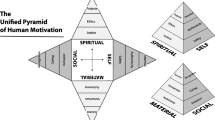Abstract
Baumeister’s energizing call-to-arms suggests theorists might wish to adopt more “radical” approaches toward theorizing about the role of motivation in human action. By radical, I mean re-igniting strands of theoretical analysis that were once more common in psychological scholarship but which have fallen to the wayside. At the heart of this argument is the proposal that theorists adopt an explicit systems approach to the study of motivation. Motivation would be neither a property of the organism potentially harboring it nor of the environment that triggers it. Instead, the complex interplay between the organism and environment would be the primary object of analysis. With this in mind, it would be wise to make three specific three notes. First, people are motivated not only by what they want to do, they literally feel anxious to avoid undesired actions and outcomes, too. Second, adaptive motivation would likely match motive to affordances in the environment that aid in motivational pursuits. Third, it might be important to identify a basic level in motivations, the level of motivational specificity containing the motives that predominantly drive human action.
Similar content being viewed by others
References
Baumeister, R. F. (2016). Toward a general theory of motivation: Problems, challenges, opportunities, and the Big Picture. Motivation and Emotion, (this issue).
Carver, C. S., & White, T. L. (1994). Behavioral inhibition, behavioral activation, and affective responses to impending reward and punishment: The BIS/BAS scales. Journal of Personality and Social Psychology, 67, 319–333.
Dunning, D. (2015). Motivational theories. In B. Gawronski & G. Bodenhausen (Eds.), Theory and explanation in social psychology (pp. 108–131). New York: Guilford.
Dunning, D., Anderson, J. E., Schlösser, T., Ehlebracht, D., & Fetchenhauer, D. (2014). Trust at zero acquaintance: More a matter of respect than expectation of reward. Journal of Personality and Social Psychology, 107, 122–141.
Dunning, D., Fetchenhauer, D., & Schlösser, T. (in press). The psychology of respect: A case study of how behavioral norms regulate human action. In A. Elliot (Ed.), Advances in motivation science (vol. 3). New York: Elsevier.
Festinger, L. (1957). A theory of cognitive dissonance. Stanford, CA: Stanford University Press.
Festinger, L., & Carlsmith, J. M. (1959). Cognitive consequences of forced compliance. Journal of Abnormal and Social Psychology, 58, 203–210.
Fetchenhauer, D., & Dunning, D. (2009). Do people trust too much or too little? Journal of Economic Psychology, 30, 263–276.
Fetchenhauer, D., & Dunning, D. (2012). Betrayal aversion versus principled trustfulness: How to explain risk avoidance and risky choices in trust games. Journal of Economic Behavior & Organization, 81, 534–541.
Gable, L. S., Reis, T. J., & Elliot, A. J. (2000). Behavioral activation and inhibition in everyday life. Journal of Personality and Social Psychology, 78, 1135–1149.
Gibson, J. J. (1977). The theory of affordances. In R. Shaw & J. Bransford (Eds.), Perceiving, acting, and knowing: Toward an ecological psychology (pp. 67–82). Hillsdale, NJ: Lawrence Erlbaum.
Gibson, J. J. (1979). The ecological approach to visual perception. Boston: Houghton Mifflin.
Gray, J. A. (1981). A critique of Eysenck’s theory of personality. In H. Eysenck (Ed.), A model of personality (pp. 246–276). New York: Springer.
Heine, S. J., Proulx, T., & Vohs, K. D. (2006). The meaning maintenance model: On the coherence of social motivations. Personality and Social Psychology Review, 10, 88–110.
Hennig, B. (2009). The four causes. Journal of Philosophy, 106, 137–160.
Mace, W. M. (1977). James J. Gibson’s strategy for perceiving: Ask not what’s inside your head, but what your head’s inside of. In R. E. Shaw & J. Bransford (Eds.), Perceiving, acting, and knowing. Hillsdale, NJ: Erlbaum.
Rosch, E. (1978). Principles of categorization. In E. Rosch & B. B. Lloyd (Eds.), Cognition and categorization (pp. 27–48). Hillsdale, NJ: Lawrence Erlbaum Associates.
Rosch, E., Mervis, C. B., Gray, W., Johnson, D., & Boyes-Braem, P. (1976). Basic objects in natural categories. Cognitive Psychology, 8, 382–439.
Schlösser, T., Fetchenhauer, D., & Dunning, D. (in press). Against all odds? The emotional dynamics underlying trust. Decision.
Schlösser, T., Mensching, O., Dunning, D., & Fetchenhauer, D. (2015). Trust and rationality: Shifting normative analyses in risks involving other people versus nature. Social Cognition, 33, 459–482.
Funding
The article was supported by no outside funding.
Author information
Authors and Affiliations
Corresponding author
Ethics declarations
Conflict of interest
Dunning declares that he has no conflict of interest.
Human and animal rights
This article does not contain any study with human participants or animals.
Rights and permissions
About this article
Cite this article
Dunning, D. Systems approaches to the treatment of motivation in human action: Three notes. Motiv Emot 40, 27–30 (2016). https://doi.org/10.1007/s11031-015-9533-7
Published:
Issue Date:
DOI: https://doi.org/10.1007/s11031-015-9533-7



